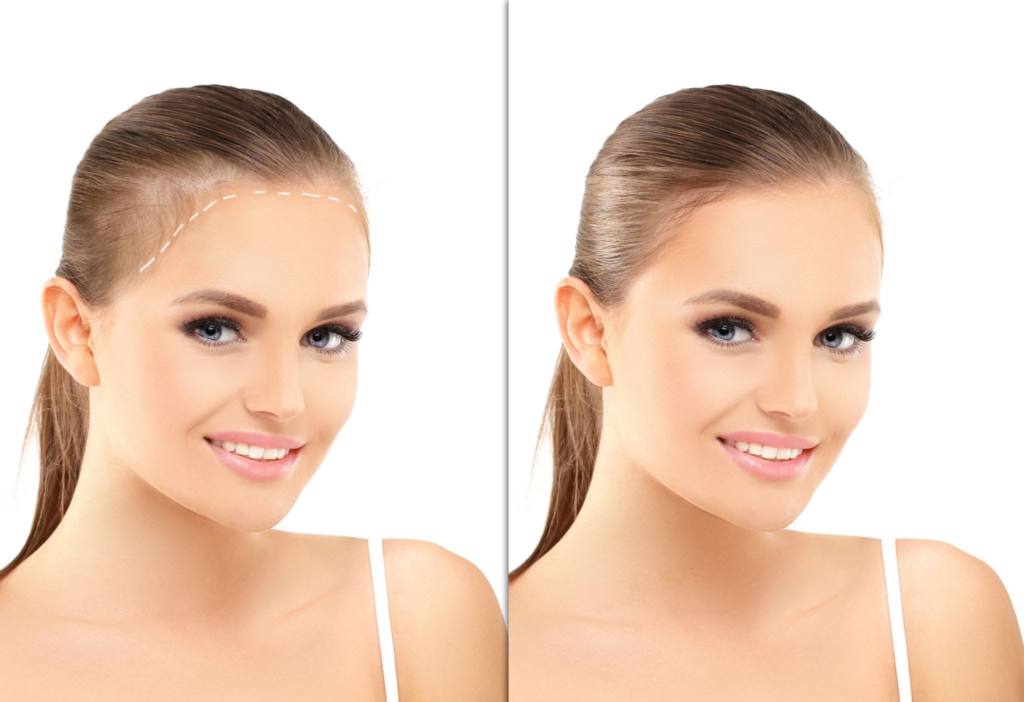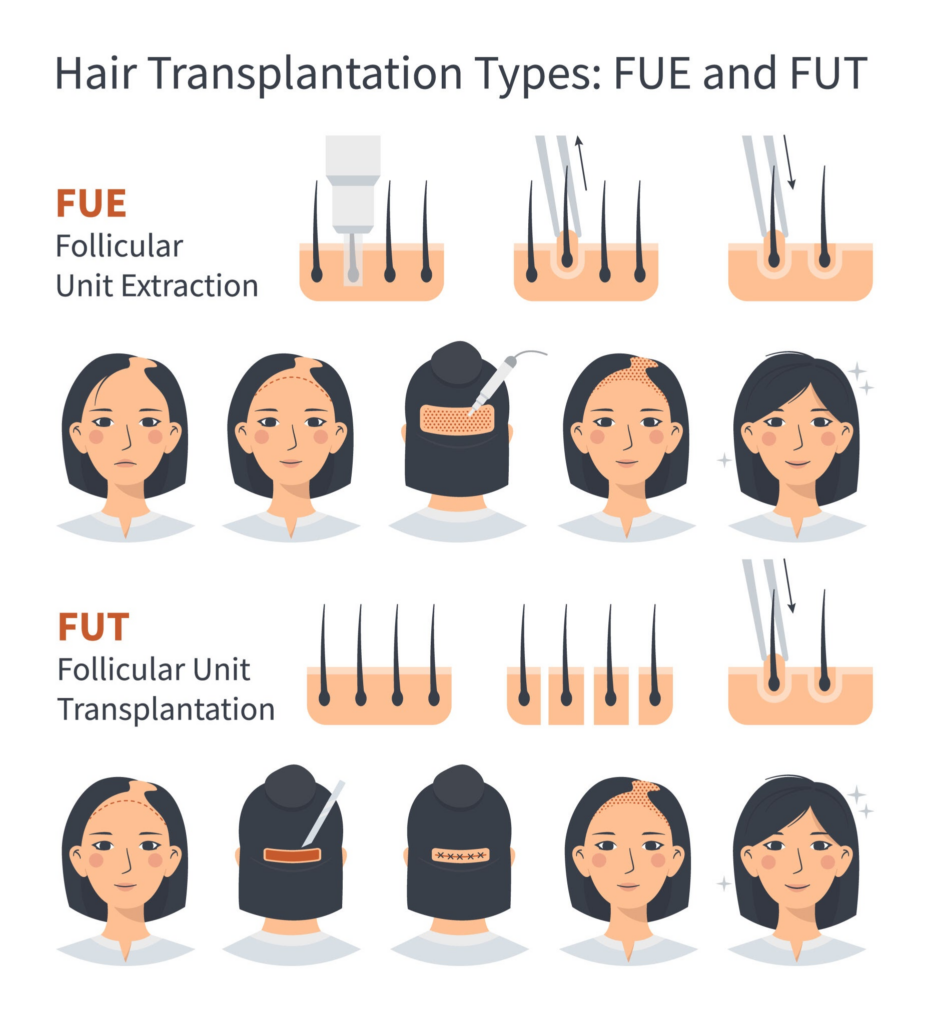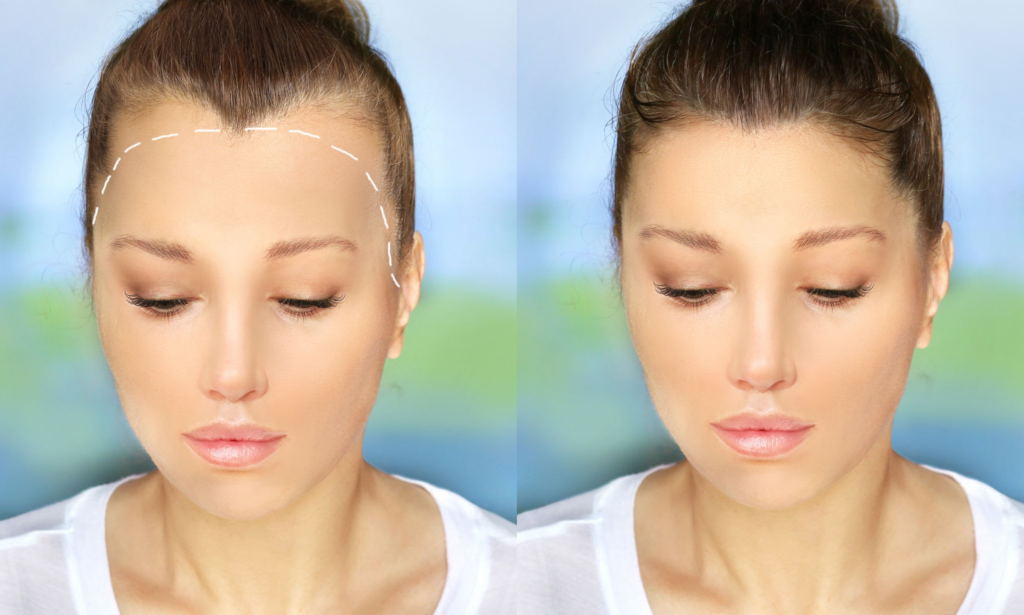Table of Contents
The Impact of FFS on Hairline
For transgender women seeking facial feminization surgery (FFS), achieving a natural and harmonious hairline is a crucial aspect. A hairline that complements facial features significantly impacts the overall aesthetic outcome. However, FFS procedures can sometimes alter the hairline, raising concerns about potential hair loss. Let’s delve deeper into the fascinating world of FFS and its impact on hairlines.

Hairline Advancement Procedures and Potential Hair Loss
Several FFS procedures can affect the hairline. Here are the two most common:
- Forehead Contouring: This procedure aims to reduce the prominence of the brow bone and forehead. During this process, the surgeon may remove a strip of scalp tissue along the hairline. While this reduces forehead height, it can also potentially lead to hairline recession.
- Scalp Advancement: This more extensive procedure involves physically moving the scalp tissue forward. This advancement lowers the hairline and creates a more feminine shape. However, it can also potentially cause some degree of permanent hair loss in the donor area.
It’s important to understand that hair loss after FFS is not guaranteed. Many factors influence the likelihood and severity of hair loss, including:
- Surgical Technique: A skilled and experienced surgeon who prioritizes scalp tissue preservation can minimize the risk of hair loss. Techniques like utilizing scalp expanders beforehand can also help.
- Individual Hair Loss Pattern: Those with a family history of male pattern baldness (MPB) may be more prone to hair loss after FFS procedures that involve scalp manipulation.
- Blood Supply: The surgeon needs to ensure adequate blood flow to the relocated scalp tissue during advancement procedures. Disruptions in blood supply can lead to hair follicle death and permanent hair loss.
Remember: A thorough consultation with a board-certified facial plastic surgeon experienced in FFS is vital. They can assess your individual hair characteristics, scalp laxity, and potential risks for hair loss.
Considerations for Hair Loss Due to FFS Scarring
Even with a skilled surgeon, some degree of scarring is inevitable after FFS procedures, particularly with scalp advancement. Scarring can sometimes affect hair growth in the affected area. Here’s what to consider:
- Scar Tissue Formation: Scar tissue can be less hospitable to hair follicles compared to healthy scalp tissue. This can lead to patchy hair growth or permanent bald spots within the scar.
- Scar Minimization Techniques: Surgeons employ various techniques to minimize scarring, including meticulous suturing and minimizing tension on the scalp.
- Hair Transplant Options: If scarring does impact hair growth, hair transplant surgery can be a viable option for restoring a natural hairline post-FFS.
While the possibility of hair loss is a concern, it shouldn’t deter you from pursuing FFS. Open communication with your surgeon and realistic expectations are key.
Assessing Donor Hair Suitability: Will Your Hair Work for Transplants?
So, you’ve embarked on the exciting journey of facial feminization surgery (FFS) and are thrilled with the results. But wait, what’s this? The hairline you envisioned might require some additional TLC. Fear not, my fabulous friends! Hair transplantation can be a fantastic option to achieve a natural, feminine hairline that complements your newfound facial features. But before you dive headfirst into the world of follicular units, there’s a crucial first step: assessing donor hair suitability.
Hair Quality and Density Requirements
Think of your donor area as the hair bank that fuels your transplant dreams. For successful hair transplantation, the hair in this area needs to be strong, healthy, and resistant to DHT (dihydrotestosterone), the hormone responsible for male pattern baldness (MPB).
Here’s what surgeons typically look for in donor hair:
- Caliber: Ideally, the hair follicles should be fine and single-stranded, mimicking the delicate texture of feminine hair. Coarse, multi-stranded follicles might look out of place in a newly crafted hairline.
- Color: Matching the donor hair color to your existing hair is essential for a seamless look.
- Density: The density of hair follicles in the donor area determines how many grafts can be harvested for transplantation. Generally, surgeons aim for areas with a high density to ensure enough follicles for achieving the desired hairline shape and density.
Now, let’s talk about some real-life scenarios:
Imagine Sarah, who has undergone FFS and desires a softer, more rounded hairline. Her surgeon will assess the hair at the back and sides of her head, the classic donor zones. If Sarah’s hair in these areas is fine, dense, and shows minimal signs of thinning, it’s a good sign! However, if Sarah has naturally coarse hair or a family history of MPB, the surgeon might explore alternative donor areas or discuss the potential need for additional procedures to improve hair quality in the traditional donor zones.
Another factor to consider is hormonal changes. Hormone replacement therapy (HRT) is often part of a transgender woman’s journey, and it can positively impact hair quality. In some cases, HRT can even improve the density and thickness of hair in the donor area, making it more suitable for transplantation.
Donor Area Selection After FFS Considerations
FFS procedures can sometimes alter the traditional donor areas, particularly procedures involving scalp advancement. Here’s what to keep in mind:
- Scarring: Scar tissue from FFS procedures can limit the availability of viable donor follicles. A skilled surgeon will carefully assess the scalp during the consultation and discuss alternative donor sites if necessary.
- Scalp Laxity: The elasticity of the scalp can influence donor site selection. For instance, scalp advancement might tighten the scalp in the traditional donor zones, making it less suitable for harvesting grafts.
Remember: A thorough consultation with a board-certified hair transplant surgeon experienced in working with transgender patients is vital. They can assess your individual hair characteristics, scalp laxity, and any limitations due to FFS to determine the most suitable donor area for achieving your desired results.
Cultivating Confidence: The Journey of Hair Transplant Recovery After FFS
Having achieved the dream results of your facial feminization surgery (FFS), you’re ready to step into the world with newfound confidence. But wait a second, what about that hairline? Hair transplantation can be the perfect solution to craft a feminine hairline that complements your beautiful features. However, it’s important to remember that hair transplantation, like any surgery, requires a dedicated recovery period. This journey, though temporary, is crucial for achieving optimal results and maximizing the longevity of your transplanted hair. Let’s delve into the world of hair transplant recovery after FFS, equipping you with the knowledge and tools for a smooth and successful journey.
Setting Realistic Expectations for Hair Growth
Patience is key, darling! Unlike sprinkling fairy dust, hair transplantation is a biological process that takes time to yield visible results. Here’s a breakdown of the typical timeline:
- The First Few Days: Immediately following surgery, you might experience some swelling, redness, and scabbing around the donor and recipient areas. Don’t fret, these are temporary and will subside within a week or two with proper care.
- The Shedding Phase (1-4 weeks): This might sound alarming, but it’s actually a normal part of the process! The transplanted follicles go through a resting phase, causing the initial transplanted hairs to shed. But fear not, the good stuff is coming!
- The Growth Phase (4-8 months): This is where the magic happens! The transplanted follicles settle in and begin producing new hair growth. You’ll likely start noticing wispy new hairs around the 4-month mark, with growth steadily increasing over the following months.
- The Final Result (12-18 months): By the 12-18 month mark, you can expect to see the full impact of your hair transplant, with a natural-looking, permanently established hairline that complements your fabulous features.
Now, let’s address some common concerns:
- Will the transplanted hair match my existing hair? A skilled surgeon will carefully select donor hair that matches the texture, color, and density of your existing hair for a seamless blend.
- What if I don’t see results by the expected timeline? Everyone heals at their own pace. While the timeline above provides a general guideline, slight variations are normal. If you have any concerns, don’t hesitate to reach out to your surgeon.
Potential Side Effects and Post-Operative Care
Knowledge is power, especially when it comes to recovery. Here’s a heads-up on some potential side effects and essential post-operative care tips:
- Mild Discomfort: You might experience some tenderness or scalp tightness following surgery. Pain medication prescribed by your surgeon can help manage discomfort.
- Itching: As the scabs heal, itching is a common occurrence. Resist the urge to scratch, as this can damage the transplanted hair. Gently pat the area or use a cool compress for relief.
- Sleeping Position: For the first few weeks, it’s recommended to sleep with your head elevated to minimize swelling. Invest in a comfortable neck pillow for support.
Here are some golden rules for post-operative care:
- Follow your surgeon’s instructions meticulously. This includes cleaning the scalp, applying any prescribed medications, and avoiding strenuous activity.
- Embrace gentle hair care. For the first few weeks, use a soft brush and lukewarm water when washing your hair. Avoid harsh shampoos and styling products.
- Protect your scalp from the sun. Sun exposure can hinder healing and irritate the scalp. Wear a hat or use sunscreen with SPF 30 or higher when outdoors.
Remember: By following your surgeon’s instructions and practicing diligent post-operative care, you’ll be well on your way to a smooth and successful recovery.
Bonus Tip: Surround yourself with a supportive network of friends, family, or online communities. Sharing your experiences and connecting with others who have undergone similar procedures can be incredibly empowering during the recovery process.
A. Introduction to Hair Transplants
Hair loss can be a distressing experience for many individuals, impacting their self-esteem and confidence. Fortunately, advancements in medical science have provided solutions to address this concern, one of which is hair transplantation. This procedure involves transferring hair follicles from one part of the body to another, typically from a donor site to the area experiencing hair loss.

B. Types of Hair Transplant Procedures
There are two primary techniques used in hair transplantation: Follicular Unit Transplantation (FUT) and Follicular Unit Extraction (FUE). FUT involves removing a strip of scalp from the donor area, while FUE involves extracting individual hair follicles directly from the scalp. Both methods have their advantages and are chosen based on individual needs and preferences.
C. Considerations Before Opting for a Hair Transplant
Before undergoing a hair transplant, it’s essential to consider various factors such as the extent of hair loss, the quality of donor hair, expectations, and overall health. Consulting with a qualified healthcare provider or a hair restoration specialist can help individuals make informed decisions about whether a hair transplant is the right option for them.

Thinning Hair After FFS: Causes and Concerns
A. Exploring Thinning Hair After Facial Feminization Surgery (FFS)
Facial Feminization Surgery (FFS) is a set of procedures aimed at altering facial features to create a more feminine appearance. While FFS can be life-changing for many transgender individuals, it may also result in unexpected side effects, including thinning hair.
B. Factors Contributing to Hair Thinning Post-FFS
Several factors can contribute to hair thinning after FFS, including hormonal changes, stress, genetics, and surgical trauma. Understanding these factors is crucial for developing effective strategies to address thinning hair and restore confidence in affected individuals.
C. Psychological Impact of Thinning Hair After FFS
Hair loss can have a significant psychological impact, affecting self-image, confidence, and overall well-being. For individuals who have undergone FFS, thinning hair may compound existing feelings of dysphoria and dissatisfaction with their appearance. It’s essential to provide support and resources to help individuals cope with these challenges.

Hair Transplants as a Solution for Thinning Hair After FFS
A. Assessing the Feasibility of Hair Transplants for Filling in Thinning Hair
Hair transplants offer a promising solution for individuals experiencing thinning hair after FFS. By transplanting healthy hair follicles into the affected areas, it’s possible to restore hair density and achieve a more natural-looking appearance.
B. Effectiveness of Hair Transplants in Restoring Hair Density Post-FFS
Numerous studies have demonstrated the effectiveness of hair transplants in restoring hair density and improving overall satisfaction among FFS patients. The procedure can significantly enhance self-esteem and quality of life for individuals struggling with thinning hair.
C. Potential Risks and Considerations for Hair Transplantation in FFS Patients
While hair transplantation is generally considered safe, it’s essential for FFS patients to be aware of potential risks and complications, such as scarring, infection, and graft failure. Working with experienced surgeons who specialize in FFS-related procedures can minimize these risks and ensure optimal outcomes.

The Future of Hair Restoration for FFS Patients
A. Advancements in Hair Transplant Technology and Techniques
Ongoing advancements in hair transplant technology and techniques hold promise for further improving outcomes for FFS patients. Innovations such as robotic-assisted hair transplantation and stem cell therapy are expanding the possibilities for hair restoration and enhancing patient satisfaction.
B. Integrating Hair Transplants into Comprehensive FFS Procedures
As awareness of the importance of holistic care for transgender individuals grows, there is increasing recognition of the role of hair restoration in comprehensive FFS procedures. Integrating hair transplants into treatment plans can help address patients’ aesthetic concerns and contribute to their overall well-being.
C. Addressing Unmet Needs and Challenges in Hair Restoration for FFS Patients
Despite significant progress, there are still unmet needs and challenges in hair restoration for FFS patients, including access to care, affordability, and cultural competency among healthcare providers. Addressing these issues requires collaboration between clinicians, researchers, and advocacy organizations to ensure equitable access to quality care for all individuals.
Summary and FAQs
A. Recap of Key Findings and Insights
In summary, hair transplants offer a viable solution for individuals experiencing thinning hair after FFS, helping restore confidence and improve quality of life. By understanding the causes of hair loss, exploring treatment options, and considering the latest advancements in hair restoration technology, FFS patients can make informed decisions about their care.
Visit Dr.MFO Instagram profile to see real patient transformations! Get a glimpse of the incredible results achieved through facial feminization surgery and other procedures. The profile showcases before-and-after photos that highlight Dr. MFO’s expertise and artistic vision in creating natural-looking, beautiful outcomes.
Ready to take the next step in your journey? Schedule a free consultation with Dr. MFO today. During the consultation, you can discuss your goals, ask any questions you may have, and learn more about how Dr. MFO can help you achieve your desired look. Don’t hesitate to take advantage of this free opportunity to explore your options and see if Dr. MFO is the right fit for you.
B. Frequently Asked Questions About Hair Transplants After FFS
Does FFS include hair transplant?
No, Facial Feminization Surgery (FFS) typically focuses on altering facial features to create a more feminine appearance. Hair transplant procedures are separate and may be performed as a complementary treatment for individuals experiencing hair loss or thinning after FFS.
How much does FFS hairline cost?
The cost of FFS hairline procedures can vary depending on factors such as the extent of the procedure, the surgeon’s expertise, and the geographic location of the clinic. On average, FFS hairline procedures may range from several thousand to tens of thousands of dollars.
Is it normal to lose hair after FFS?
Yes, it is not uncommon for individuals to experience temporary hair shedding or thinning after undergoing FFS. This can be attributed to factors such as surgical trauma, stress, and hormonal changes. In most cases, hair loss is temporary, and regrowth typically occurs within a few months.
How do you wash your hair after FFS?
After FFS, it’s essential to follow any specific post-operative instructions provided by your surgeon. Generally, you should gently cleanse your hair using a mild shampoo and lukewarm water, avoiding vigorous scrubbing or rubbing of the scalp. Pat your hair dry with a soft towel and avoid using heat styling tools until cleared by your surgeon.
When can I dye my hair after FFS?
It’s recommended to wait until your scalp has fully healed and any stitches or sutures have been removed before dyeing your hair after FFS. This typically takes several weeks to a few months, depending on individual healing times and the extent of the surgical procedure. Consult with your surgeon for specific guidance.
Is it normal to lose hair after FFS?
Yes, it’s normal for some individuals to experience temporary hair shedding or thinning after FFS due to factors such as surgical trauma, stress, and hormonal changes. This is typically a temporary condition, and hair regrowth is expected within a few months following the procedure.
How do you wash your hair after FFS?
After FFS, it’s important to wash your hair gently to avoid disrupting the healing process. Use a mild shampoo and lukewarm water, gently massaging the scalp with your fingertips. Avoid vigorous scrubbing or rubbing, and be cautious around any incision sites. Pat your hair dry with a soft towel and avoid using heat styling tools until cleared by your surgeon.
C. Conclusion: Empowering FFS Patients with Hair Restoration Options
In conclusion, hair transplants offer FFS patients a valuable option for addressing thinning hair and reclaiming their confidence and self-esteem. By staying informed, seeking guidance from qualified professionals, and exploring available treatment options, individuals can take proactive steps toward achieving their desired aesthetic goals and leading fulfilling lives.




